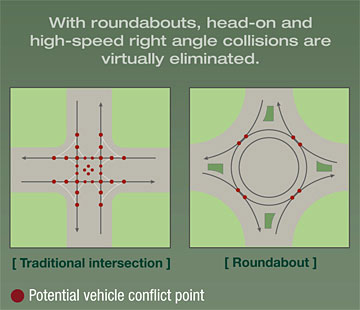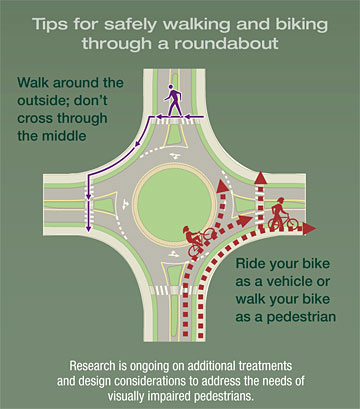Roundabout FAQs
On this page:
What is a roundabout?
A roundabout is a type of circular intersection with yield control of entering traffic, islands on the approaches, and appropriate roadway curvature to reduce vehicle speeds.
Modern roundabouts are different from rotaries and other traffic circles. For example, roundabouts are typically smaller than the large, high-speed rotaries still in use in some parts of the country. In addition, roundabouts are typically larger than neighborhood traffic circles used to calm traffic.
Why a roundabout?

Compared to other types of intersections, roundabouts have demonstrated safety and other benefits. Roundabouts:
- Improve safety
- Reduce congestion
- Efficient during both peak hours and other times
- Typically less delay
- Reduce pollution and fuel use
- Fewer stops and hard accelerations, less time idling
- Save money
- Often no signal equipment to install, power, and maintain
- Smaller roundabouts may require less right-of-way than traditional intersections
- Often less pavement needed
- Complement other common community values
- Quieter operation
- Functional and aesthetically pleasing
How do I navigate a roundabout?

There are just a few simple guidelines to remember when driving through a roundabout:
- Slow down.
- Yield to pedestrians and bicyclists.
- Yield at the entry to circulating traffic.
- Stay in your lane within the roundabout and use your right-turn signal to indicate your intention to exit.
- Always assume trucks need all available space — don't pass them!
- Clear the roundabout to allow emergency vehicles to pass.
Visit safety.fhwa.dot.gov to learn more about roundabouts.
Source: Roundabouts: An Informational Guide. Federal Highway Administration, Washington, D.C., latest version, except as noted.
[1] "Safety Effect of Roundabout Conversions in the United States: Empirical Bayes Observational Before-After Study." Transportation Research Record 1751, Transportation Research Board (TRB), National Academy of Sciences (NAS), Washington, D.C., 2001.
[2] NCHRP Report 572: Roundabouts in the United States. National Cooperative Highway Research Program, TRB, NAS, Washington, D.C., 2007.
